Executive summary
- Pressure has continued in emergency departments across the country, with 2.1 million attendances and 522,000 emergency admissions in September 2023, an increase of 7.8% and 7.1% respectively on the same month last year.
- Industrial action in the NHS continues to have a significant impact on patients. As of 6 October 2023, a total of 1.1 million appointments had been rescheduled since strike action began.
- The target to reach 10,000 virtual ward capacity by September 2023 as part of the delivery plan for recovering urgent and emergency care (UEC) services has been achieved, with 10,421 virtual ward beds in place as of the 22 September 2023.
- The NHS continues to increase support to those outside of hospital. Urgent community response helps avoid hospital admissions by providing urgent care to people in their homes. Integrated care boards (ICBs) now have full coverage and provisional data from August 2023 shows that nationally 84% of patients were seen within the 2-hour standard.
- In diagnostics, the NHS is continuing to increase community access and overall activity levels, and in August 2023, more than 2.2 million tests and checks were carried out, an increase of more than 180,000 on the same month last year.
- Demand for cancer services continued at record levels in August 2023, with the number of urgent suspected cancer referrals at 125% of pre-pandemic levels. Treatment is also at record levels and cancer deaths are around 10% lower in the UK compared to just five years ago.
- Good progress continues to be made in activity levels in general practice. In August 2023, 28.3 million GP appointments took place. 43.7% of appointments in June took place on the same day that they were booked, and 67.9% were carried out face-to-face.
- The NHS continues to expand mental health services to meet rising demand. More people than ever before now receive NHS support for their mental health, with five million patients accessing care in 2022/23, an increase of over one million in five years.
Urgent and emergency care
Alongside a heatwave and ongoing industrial action, urgent and emergency care (UEC) services faced extremely high demand in September.
There were 2,165,741 attendances in A&Es across England, an average of 72,191 per day. This is an increase of 6.3% per day compared to August 2023.
71.6% of patients attending A&E were admitted, transferred or discharged within four hours. This compares to 71.1% in September 2022.
Percentage of patients seen within four hours in A&E departments
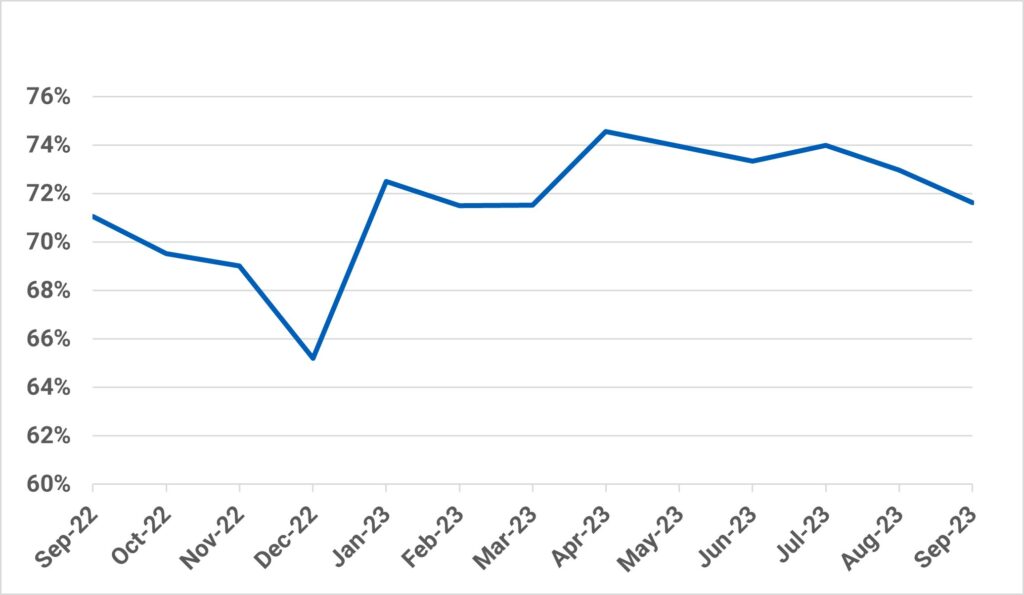
Ambulance services answered 827,690 calls to 999, or 27,590 per day. This is an increase of 11% per day compared to August. They also handled 697,411 incidents.
The average response time for a category-two call was 37 minutes and 38 seconds – a faster response time of 10 minutes and 21 seconds compared to September 2022.
Average C2 response times
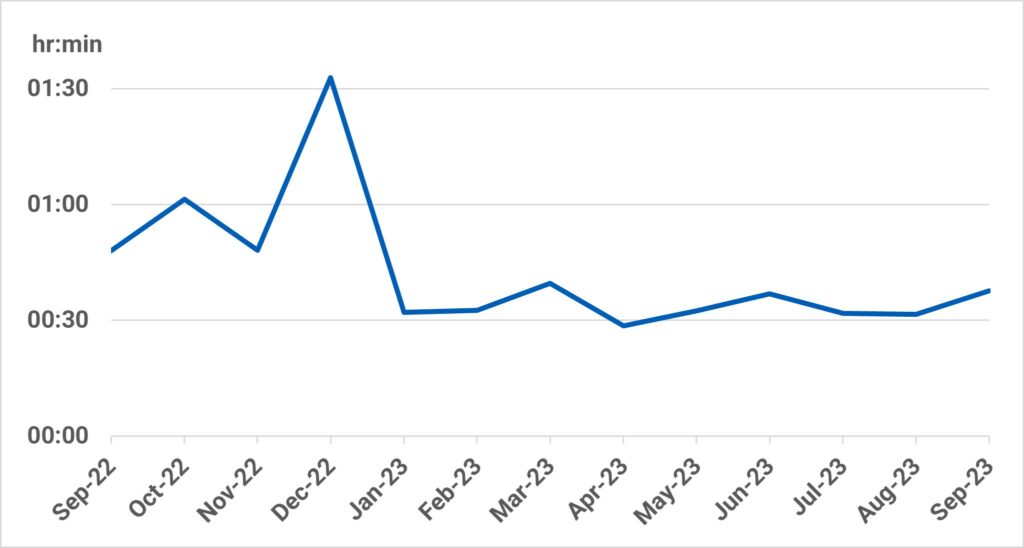
Despite demand and dealing with the challenging impact of strikes, the NHS is continuing to prepare for winter. This includes expanding the use of out-of-hospital care.
Urgent community response (UCR) teams provide urgent care to people in their homes, helping to avoid hospital admissions and enabling people to live independently for longer. Through these teams, people who urgently need care can get fast access to a range of health and social care professionals within two hours.
The aim is to improve use of UCR ahead of winter to help improve patient care, ease pressure on ambulance services and avoid unnecessary hospital admissions. Provisional data shows 84% of UCR referrals met the two-hour standard in August.
September’s data shows we have met our ambition to scale up capacity to more than 10,000 virtual ward beds. 10,421 beds were available on the 22 September, helping people get hospital-level care at home safely and in familiar surroundings.
Elective recovery
Six days of industrial action significantly disrupted planned care in August, with more than 100,000 elective procedures and outpatient appointments rescheduled.
As of the end of August, 8,998 (0.1%) patients were waiting more than 78 weeks for treatment. This is down by more than 82% since August 2022.
Referral-to-treatment 78-week waits*
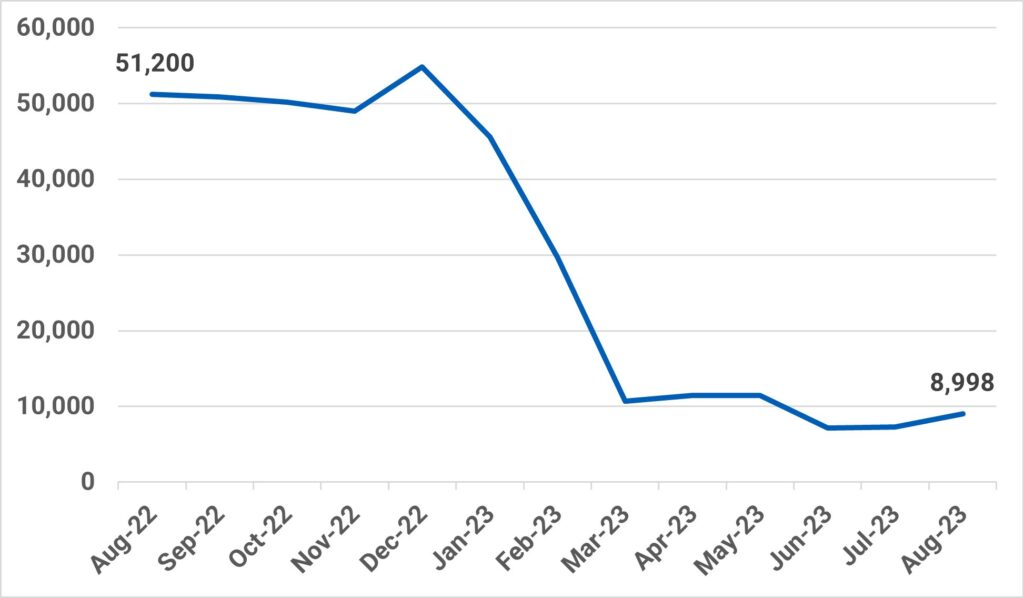
109,523 (1.4%) patients were waiting more than 65 weeks for treatment. This is down by 31% since August 2022.
Referral-to-treatment 65-week waits*
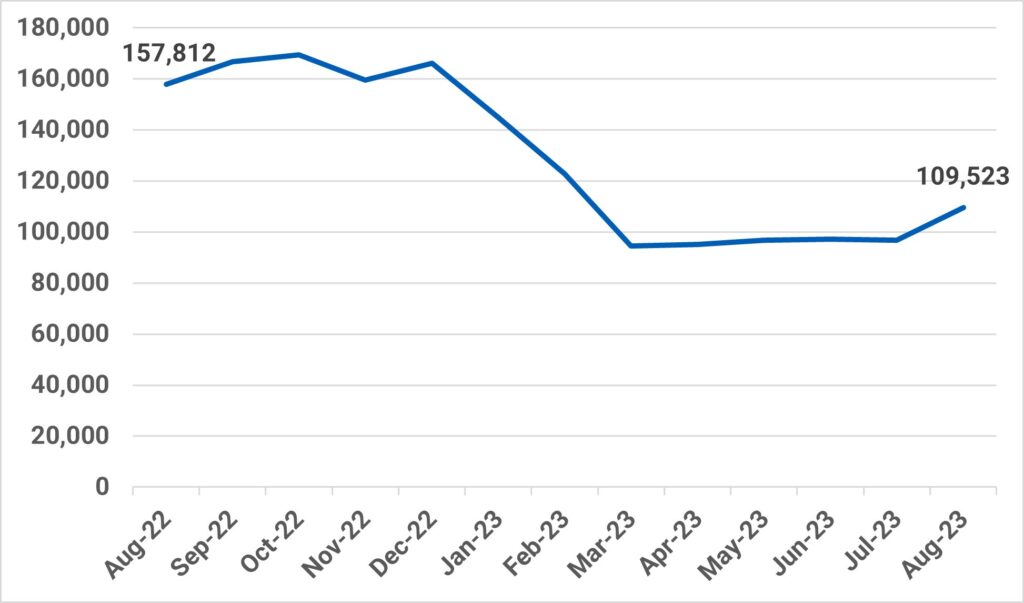
Despite staff dealing with the operational impact of strikes, 961,109 patients started treatment within 18 weeks of referral. This is an increase of 0.1% from July and 2.7% from the same month last year.
*including estimates for missing acute trusts
Cancer
Demand for cancer services continued at record levels in August with the number of urgent suspected cancer referrals at 126% of pre-pandemic levels. To meet high demand, treatment is also at record levels.
Urgent suspected cancer referrals first seen
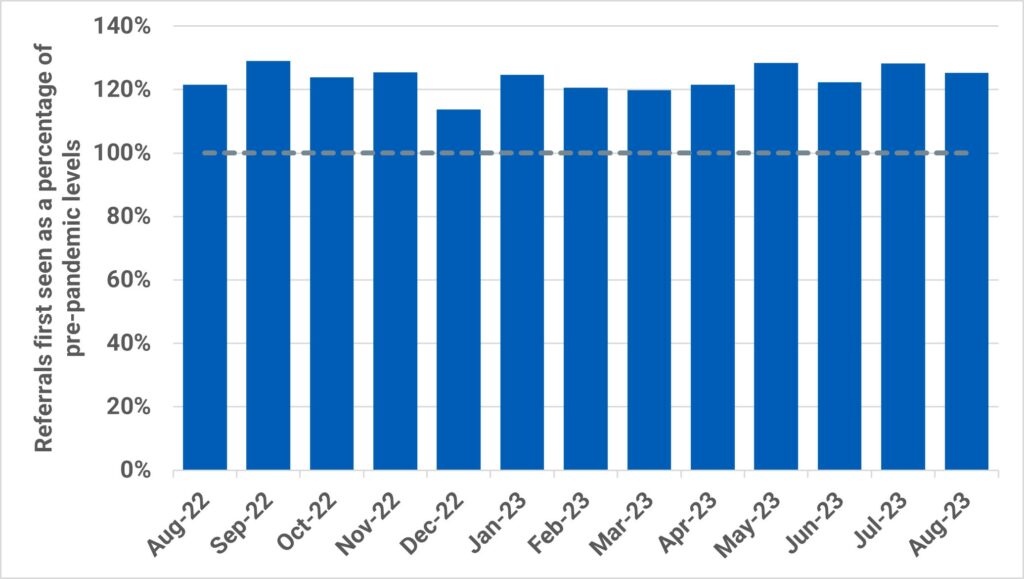
Over 335,000 people received treatment for cancer over the last year between September 2022 and August 2023 – the highest year on record, and up by more than 22,000 on the same period pre-pandemic.
GPs have been referring people for urgent cancer checks in record numbers since March 2021. Since then, NHS staff have seen over a million more people than in the same period prior to the pandemic.
The increase in referrals has contributed to the NHS diagnosing more cancer at an early stage than ever before. We are diagnosing a higher proportion of cancers at an early stage now than ever before – about 2% higher than before the pandemic.
Survival is also at an all-time high. In 2023, the Annals of Oncology published findings showing that cancer deaths are around 10% lower in the UK compared to just five years ago.
Cancer early diagnosis rate across England
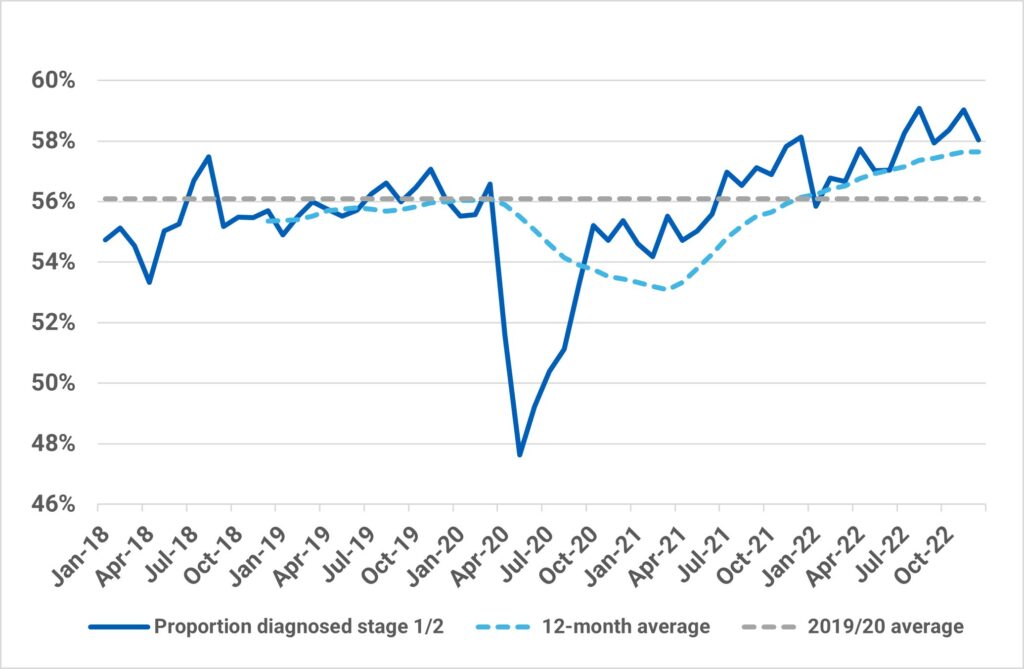
The NHS is working hard to keep up with this increase in demand. It has been accelerating the installation of new diagnostic capacity, much of it in community diagnostic centres.
The backlog has already reduced by 14,000 people since its peak last summer, and despite the recent seasonal increase, NHS staff remain focused on ensuring that people who have been waiting longest or who need care most urgently are seen first.
Learning disabilities and autism
People with a learning disability experience significant health inequalities. They die much younger than the general population and are more likely to be living with long term health conditions like epilepsy and diabetes.
Annual health checks and completed health action plans are important ways the NHS can support the health of people with a learning disability, helping individuals manage their physical and mental health, improving access to screening, and identifying health conditions early.
In 2022/23, we achieved our NHS Long Term Plan ambition – that at least 75% of people aged 14 and over on the GP learning disability register will receive an annual health check (AHC) – a year earlier than planned. 78.1% of people received an annual health check and 74.6% of people received an accompanying health action plan.
We are on track to deliver more learning disability annual health checks and health action plans in 2023/24.
Between April and July 2023, 16.8% of patients aged 14 years and over on a GP learning disability register received their annual health check and 14.8% received a health action plan, an improvement on the same period last year (16.3% and 13.6% for April to July 2022).
Percentage of patients aged 14 years and over on the GP learning disability register receiving health checks and health action plans
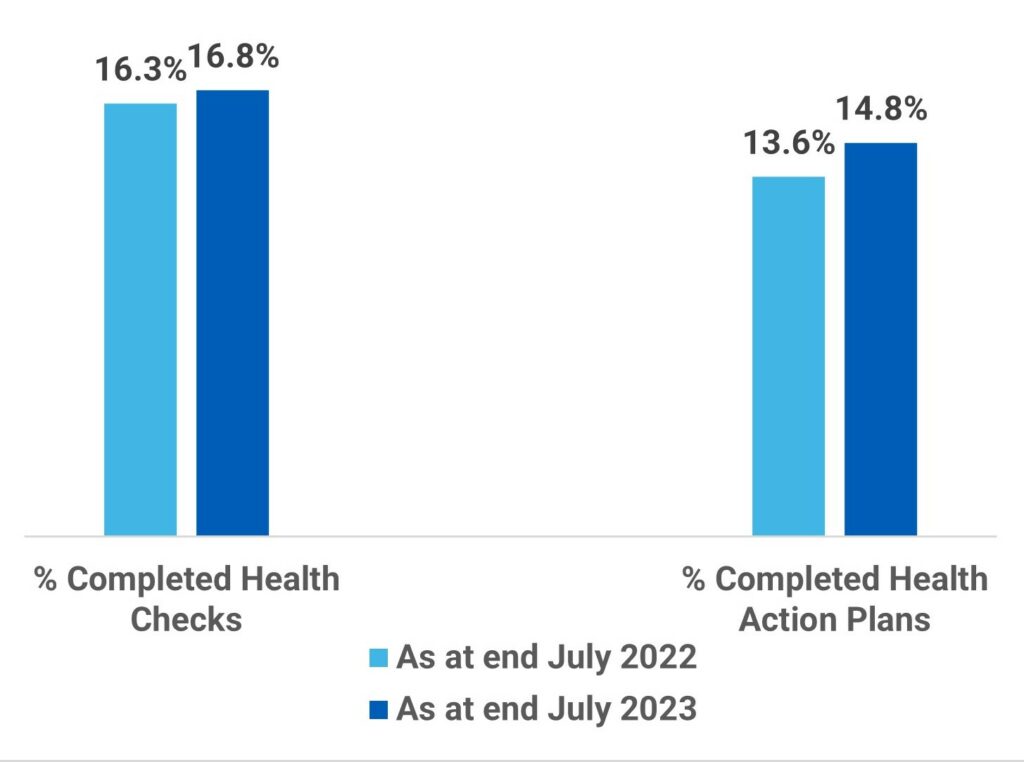
Between July 2022 and July 2023, the number of people on a GP learning disability register increased in size by 6% to 319,476, a positive step in ensuring more people can access the support they need.
Having an appropriately trained workforce is crucial in reducing health inequalities. The need for health and care staff to be trained in meeting the needs of autistic people and people with a learning disability is a new statutory requirement in the Health and Care Act 2022.
Since November 2022, there have been over 2.5 million launches of the e-learning components of training for people who require general awareness (Tier 1) or people who may need to provide care and support (Tier 2).
For the same period, there have been over 700,000 e-learning courses completed. To find out more, visit The Oliver McGowan Mandatory Training webpage.

